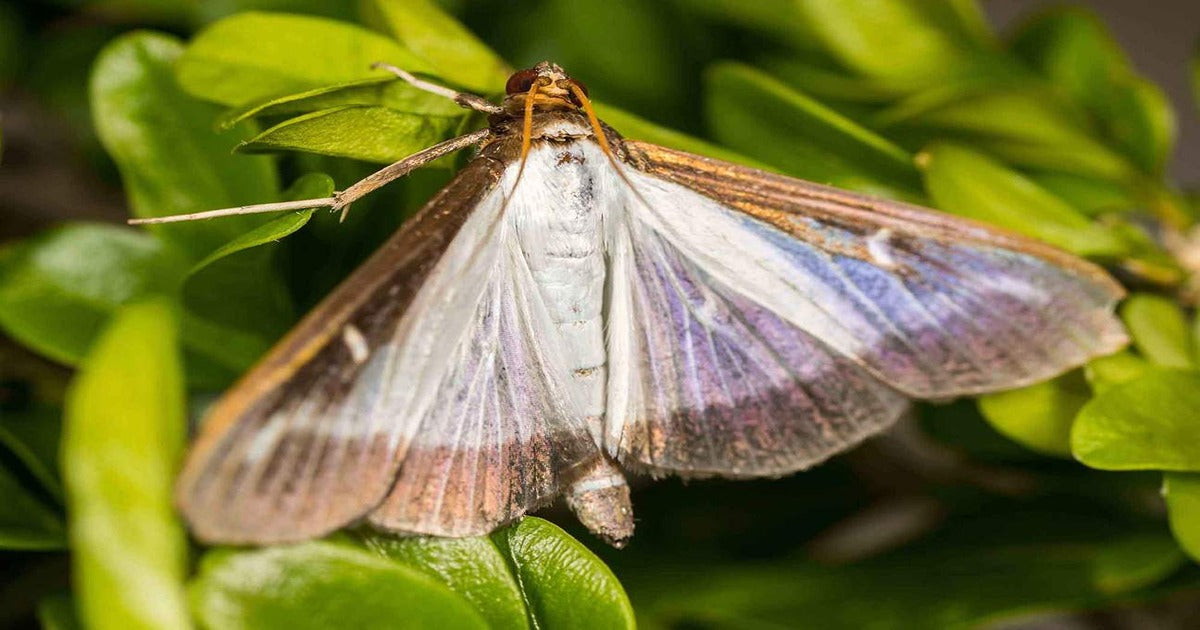
Dragonfli's Three-Step Strategy To Combat The Entire Box Tree Moth Life Cycle
Box Tree Moths overwinter as caterpillars that hide deep inside the Box Plant foliage. As temperatures warm, the caterpillars will pupate and transform into moths. The female moths will proceed to mate and begin laying eggs in little clusters on Box tree plants. These eggs will then hatch into the damaging caterpillars that devastate and kill Box plants and hedges.
Dragonfli are on hand to help, however, and can now provide natural solutions against all three stages of the Box Tree Moth life cycle!

Box Tree Caterpillars feed on Box plants and hedges and are capable of killing Buxus entirely if left untreated.
Stage 1: Catch Adult Box Tree Moths With Pheromone Traps To Reduce Egg Laying
The first step to take in combating Box Tree Moths is to set up your Box Tree Moth Pheromone Traps. These traps will catch male Box Tree Moths and prevent them from mating with females. The traps will also provide you with a valuable early warning of Box Tree Moth activity.
Our Box Tree Moth Pheromone Traps are the first key component in the three pronged attack against Box Tree Moth infestations.
Box Tree Moths have 2-3 generations a year, so it is good practice to keep your Box Tree Pheromone Traps active all spring and summer. Each pheromone lure lasts about six weeks, after which it should then be replaced. You can find replacement lures by clicking here.
Pheromone traps used solely will not catch enough Box Tree Moths to prevent entire infestations, so please be sure to also follow the next steps.

Box Tree Moths are identifiable with white coloured wings bordered by brown. They have a wingspan of roughly 4cm.
Stage 2: Use Trichogramma Parasitic Wasps To Kill Box Tree Moth Eggs
Once Box Tree Moths are observed, it won’t be long before egg laying takes place. These eggs can now be controlled, however, by tiny parasitic wasps contained in small sachets that are placed within Box tree plant foliage. The Trichogramma evanescens parasitic wasps that emerge from our Box Tree Moth Egg Killer Sachets will search the Box tree plants for Box Tree Moth eggs. Once located, the Box Tree Moth eggs are parasitised and killed. The eggs then, instead of producing Box Tree Caterpillars, release new Trichogramma wasps to locate and kill more Box Tree Moth eggs!

Our Box Tree Moth Egg Killer Sachets can be harnessed to kill Box Tree Moth eggs lain by the female Box Tree Moths that were able to mate.
The sachets will continue to release the Trichogramma wasps for up to 4 weeks. We suggest placing one sachet every 5 linear metres of Box hedging, or 1 sachet every 10 square metres. If you have large individual Box tree plants, one sachet can be applied to each plant.

Box Tree Moth eggs are often hidden, and quite difficult to spot with the human eye but don't worry our Trichogramma wasps will be able to find and kill them for you!
Stage 3: Apply Nematodes Directly Onto Box Tree Caterpillars
If Box Tree Caterpillars are observed on Box plants, apply our Box Tree Caterpillar Killer Nematodes directly onto the caterpillars. Only apply the nematodes if caterpillars are present. More than one application may be required, which is why two sachets of nematodes are included in Box Tree Caterpillar Killer. Apply the first sachet when Box Tree Caterpillars are identified, and apply the second sachet about a week later.

Simply spray our Box Tree Caterpillar Killer directly onto the caterpillars and the nematodes will enter the pest via a natural opening, before killing the caterpillars from inside.
Make sure unopened nematode sachets are stored in a fridge to keep them fresh, and avoid applying nematodes on bright, sunny days, as nematodes are U.V sensitive. The optimum conditions for applying nematodes are warm, overcast, humid days. Alternatively, simply apply the nematodes early, or late on in the day.

Box Tree Caterpillars can grow up to 30mm in length and are a greenish-yellow colour. They can be concealed within webbing spun around buxus plants.
Enjoy Renewed Box Plant Growth

These three natural solutions combine to provide a complete biological control of Box Tree Moths and protect your valuable Box Hedges and plants from this devastating pest.
If looking to provide your Box plants with a further aid to recovery, consider also applying our Soil Boost biostimulant granules.
Soil Boost acts as an organic slow release fertiliser, helping the Box plants achieve newly invigorated growth after stress and damage.
If you ever need any further advice on how to combat Box Tree Moths feel free to get in touch via email at sales@dragonfli.co.uk, via social media, or by giving us a call on 01376 563322, and we’d be happy to assist.
Comments (Responses)
Julian Ives
Hi Jane, thanks for getting in touch.
I am sorry to hear that such an old and impressive box plant is infested with the horrible Box Tree Caterpillar pests. I’m glad that the pheromone trap has caught some of the moths but indeed the treatment required would need to consist of more than just this trap.
I believe that due to the potential scale of caterpillar infestation, and relative age and size of the buxus, that the treatment required would also require more than a nematode treatment, which as you point out would also be challenging to spray in such a location.
In this case the best course of action would be to contact a company who could arrange for someone to visit that holds a professional spraying certificate. This professional would then have license to apply the product Dipel DF, which is a biological insecticide that can be used for the control of caterpillars.
Our parent company, Koppert, may be able to direct you further. Feel free to contact them here:
https://www.koppert.co.uk/contact/
I hope this helps but if you have any further questions please don’t hesitate to ask.
Kind regards, Julian Ives [Director, Dragonfli]
Jane Wolley Dod
I have a box tree which is about 400 yrs old and about 40’ high. It is situated over a public pavement and is infested with caterpillars. I can tell as the pavement is covered with the poo of the caterpillars. The tree is too high to spray and is in a public area. I would love to save it. I have pheromone
Trap it has caught about 50 moths.
Julian Ives
Hi Krystyna, thanks for getting in touch.
I can confirm that you can continue to use the lures in the same way as you have in previous years. They simply need removing from the foil sachet they arrive with you in, and placing inside the cage at the top of your Box Tree Moth Trap.
The lures have indeed changed formulation this year and the pheromone is now contained within a small rubber bung. This new formulation provides better protection and ensures a more consistent release of the pheromone.
You can find more information on the lure and trap on the product webpage and instruction leaflets are now attached to all of our product pages to view as PDFs.
Hope this helps but if you need any further advice please don’t hesitate to get in touch again.
Kind regards, Julian Ives [Director, Dragonfli]
Krystyna Dickide
I bought all three of the above to get rid of the Box Tree Caterpillar this year but bought the box tree trap itself last year. I note that the lures vary from last year but can I still use the original trap and place the new lures in this. Are there any other instructions to do beyond just placing them in the trap the same







12 September, 2023
Kirsty Duffy
Brilliant box moth trap which is full of moths after 48 hours! What do we do now? Do we drown them and replace the trap? Would buy a second trap but they are expensive… Got a second lure as well. Should we do the parasitic wasp now? Only a smallish hedge but clearly a biggish infestation. Any advice gratefully received.